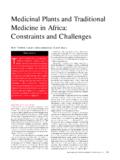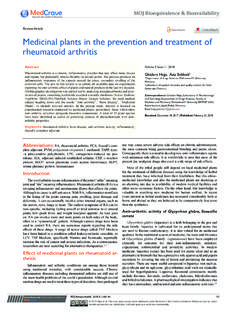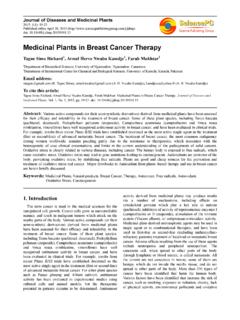Transcription of Medicinal Plant - IUCN
1 Newsletter of the Medicinal Plant Specialist Groupof the IUCN Species Survival CommissionChaired by Danna J. LeamanMedicinal PlantConservationMEDICINALPLANTSPECIALIS TGROUPS ilphionVolume 12 ISSN 1430-95X1 November 2006of Medicinal and aromatic plants Bert-JanOttens, Klaus D rbeck & Geertje Otten.. 28 Prioritisation of Medicinal plants for conservationthrough threat assessment in Madhya Pradesh,India. A paradigm shift from prescription topractice G. A. Kinhal, Ved & .. 31 Medicinal plants of the Canary Islands David Bramwell.. 36 Taxon FileConservation strategies for Commiphora important Medicinal Plant species Vineet Soni & Swarnkar.
2 40 Podophyllum hexandrumand its conservation status in India Niranjan Chandra Shah.. 42 Nepeta binaludensis, a highly endangered medi-cinal Plant of Iran Farsad Nadjafi.. 47 Conferences and MeetingsComing up Natalie Hofbauer.. 48 CITES News Uwe Schippmann.. 49 Lista de especies, nomenclatura y distribuci n enel genero Guaiacum Patricia Davila Aranda& Uwe Schippmann.. 50 Notices of Publication.. 51 List of Members.. 53 Chair s note.. 2 Resoluci n de la reuni n sat lite del Grupo deEspecialistas de Plantas Medicinales (MPSG)de la Uni n Mundial para la Naturaleza (UICN).
3 3 Resoluci n de la mesa redonda sobre directricesmundiales de conservacion y uso sostenible de plantas medicinales .. 3 Botanic Gardens: Using biodiversity to improve human well-being Kerry Waylen.. 4 Progress on the International Standard for Sus-tainable Wild Collection of Medicinal andAromatic plants (ISSC-MAP) SusanneHonnef, Danna Leaman, Britta P tzold & Uwe Schippmann.. 8 Supplier audit in MAP collection and cultivation:Buyer perspective in Germany Ernst Schneider.. 12 Towards a sustainable management of medicinaland aromatic plants : The case of the Agro-artesanal Association of Producers of DriedMedicinal plants of Ecuador AAPPSME Mar a Arg ello & Zornitza Aguilar.
4 17 Regional FileThe status of exudate species in Iran and existingchallenges in their sustainable utilization F. Nadjafi, A. Koocheki & A. Ghasemi Arian.. 22 Alleviating poverty in Afghanistan through sus-tainable resource management and marketing2 Medicinal Plant Conservation 12 Danna LeamanTwo years into the current IUCN Quadrennium (2005-2008), this 12thvolume of Medicinal Plant Conservationprovides an opportunity to revisit the ambitious workplanproposed for the Medicinal Plant Specialist Group forthis period (see Chair s Note MPC11: 2-3), to considerour successes and continuing challenges, and to reviewour group s priorities for the two years remaining beforethe IUCN Members, Commissions, and staff reconveneat the next World Conservation objective 1:Establishment of regional sub-groupsand programmes of work for the MPSG in the Pacific,Europe, North America, Southeast Asia, North Asia, andAfrica (regional sub-groups have already been establishedin South Asia and Latin America).
5 The IUCN SpeciesSurvival Commission, to which all MPSG members belong,is initiating an on-line membership registration. Buildingthis system created some delays in the process of invitingand registering new specialist group members. However,the larger part of the responsibility for the delay in movingforward on this objective is mine as Chair. Particularly inAfrica, the middle East, Europe, and North America manypotential new members have been identified. However,much remains to be done to complete the invitation processand formally establish new regional a more optimistic note, the regional Latin Americansub-group of MPSG met in June 2006 in a satellite meet-ing of the IX Latin American Botanical Congress in SantoDomingo, the Dominican Republic.
6 The group identifiedpriorities for action, mechanisms to support interactionamong the regional members, and nominated national fo-cal points for those countries represented at the resolution from this meeting, in Spanish, appears inthis volume of MPC (see p. 3).Workplan objective 2:Expansion of global conservationassessment of Medicinal plants through regional Red Listtraining and assessment projects, identification of regionalRed List Authorities for Medicinal plants in collaborationwith other SSC Specialist Groups, and support for regio-nal Medicinal Plant conservation data management have begun work with TRAFFIC and WWF to de-velop a joint programme with IUCN on conservation andsustainable use of Medicinal plants that will support preli-minary and Red List assessments, market assessments, andimplementation of models for sustainable use of medicinalplants.
7 Linking regional projects to a global strategy. I amhopeful that MPSG will be able to provide funds for regio-nal MPSG initiatives through this objective 3:Ongoing contributions to thedevelopment of a practical and widely relevant interna-tional standard for sustainable wild collection of medici-nal plants (ISSC-MAP).This has clearly been a majorfocus of our work. Our substantial progress on this objec-tive is summarized in this issue of MPC (see p. 8 f.).Workplan objective 4:Ongoing partnership throughIUCN with WHO, WWF, and TRAFFIC enabling thepublication, distribution, and implementation of the revis-ed Guidelines for the Conservation of MedicinalPlants.
8 The third draft of the revised Guidelines hasbeen completed and is currently being circulated to themembers of the steering committee. We continue our eff-orts to raise the funds required to support a final consulta-tion with the author institutions, and print/web publicationand distribution of the final guidelines. We remain com-mitted to making the Guidelines accessible in French,Spanish, Chinese, Arabic, and other languages in additionto English, to facilitate their implementation are very grateful to the Species Survival Commission,the Wildlife Conservation Society, and Swann Inter-national for funding to support completion of the thirddraft of the revised Guidelines.
9 These funds also sup-ported a Round Table on implementation of the Guidelinesin Latin America, coordinated by the MPSG regional sub-group for Latin America during the IX Latin AmericanBotanical Congress, 19-25 June 2006, in the DominicanRepublic. The Congress resolution resulting from thisRound Table is included in this volume of MPC (p. 3 f.).Workplan objective 5:Continued publication of Medi-cinal Plant Conservation and enhanced use of the MPSG website to effectively communicate current issues and ac-tions relevant to the overall aim of the and Natalie Hofbauer have worked diligentlyto bring you this issue of MPC, and we are grateful to BfNfor their continued generous support for the productionand mailing of this newsletter.
10 Work to update the mainMPSG website has been slower than I d hoped, owing tolack of time. I m grateful to MPSG member Reza Azmiand WildAsia, based in Kuala Lumpur, for their efforts tomove forward on improving design and content, and toBfN for financial support to include the ISSC-MAP pro-ject on their website. The Latin American sub-group ofMPSG has designed a regional website that will be hostedby the Grupo Etnobotanico Latinoamericana (GELA), andaccessible via the main MPSG website early in Project UpdatesRevision of CITES #-annotations for Medicinal and aro-matic plants :Work on this project, a consultancy underta-ken by the MPSG to the CITES Secretariat to identify pro-blems that may arise because of unclear annotations regar-ding Medicinal Plant species included in the Appendices ofCITES, is nearly completed (see also p.)












